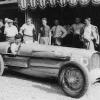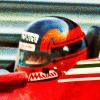
Slick tyres
#1

Posted 17 September 2005 - 19:00
Advertisement
#2

Posted 17 September 2005 - 19:51
Or one for the search engine, maybe...?Originally posted by f1steveuk
One for Doug I think
#3

Posted 17 September 2005 - 20:03
#4

Posted 18 September 2005 - 07:45
#5

Posted 21 March 2013 - 06:42
In the oft told story of slick racing tyres, it is always said that Mario Andretti was testing a new compound, but they hadn't had time to put a tread on them, and rather than wait, Mario was told to do a few slow laps, and instantly found them quicker. I find this a bit unlikely, the way tyres are manufactured the carcass would have gone in the mould complete with tread, because I cannot believe they hand cut EVERY tread. So what is the definitive story?? One for Doug I think
Apparently the first slick tyres were accidentally discovered by US drag racers in the late 1940's and early 1950's:
http://www.mandhdragtires.com/history
#6

Posted 21 March 2013 - 07:26
Why was F1 slow to use slicks? (merged)
Slicks-Starting When?
They weren't the first, though, as those threads explain.
#7

Posted 21 March 2013 - 20:20
#8

Posted 21 March 2013 - 20:52
Edit - I don't know very much about the tyre making process as applied to racing tyres in the Sixties, but I would have thought that the tread patterns were moulded in rather than cut. As tyres got wider the job of cutting treads would have become more and more onerous if they were hand done. Maybe the tyre maufacturers made "blank" moulds in addition to the treaded ones to allow for some experimentation with tread patterns that were hand cut.
Edited by Cirrus, 21 March 2013 - 21:00.
#9

Posted 21 March 2013 - 21:33


#10

Posted 21 March 2013 - 22:02
Really they copied other parts of the sport more than being copied.
This has been discussed on many other threads on TNF.
#11

Posted 21 March 2013 - 22:14
My problem is all my books are in France and I don't go home until Friday, so either someone beats me to it or I'll post it when I have found it and start the discussion again!!
Are you home yet ?
#12

Posted 21 March 2013 - 23:03
Maybe the Mario story was given added credence by the (static) photographs of the 1966 F1 Ferrari on uncut tyres.
Edit - I don't know very much about the tyre making process as applied to racing tyres in the Sixties, but I would have thought that the tread patterns were moulded in rather than cut. As tyres got wider the job of cutting treads would have become more and more onerous if they were hand done. Maybe the tyre maufacturers made "blank" moulds in addition to the treaded ones to allow for some experimentation with tread patterns that were hand cut.
Oh sorry, I misread the opening post. So the tire was 'finished' it just had to have the grooves cut into it. That's at least possible. Though I'm still not sure why you'd do even basic laps on them, if you thought you needed the grooves cut in what would you learn by going out?
#13

Posted 21 March 2013 - 23:47
Quite likely the suggestion that experimentation with hand-cutting of patterns meant they made treadless tyres, but the moulding process in which the strip of tread rubber that's laid around the outside of the carcase is heated to shape and cure it must by definition include whatever tread that tyre is intended to have.
That's basically the completion of the manufacturing process. Later hand-cutting is a different issue, of course.
#14

Posted 22 March 2013 - 01:56
Dunlop had a dry weather racing tyre in the CR70 with small crosses for tread, but apart from Mini7s, who ever used them twice.
#15

Posted 22 March 2013 - 13:54
#16

Posted 22 March 2013 - 22:14
I agree. Most treaded tyres are moulded. Some wets however start as a slick and are handgrooved surprisingly. And most start with 4-5 rings moulded and the rest are cut. The same as many dirt tyres tooYes, tyres are moulded with (or without) their treads...
Quite likely the suggestion that experimentation with hand-cutting of patterns meant they made treadless tyres, but the moulding process in which the strip of tread rubber that's laid around the outside of the carcase is heated to shape and cure it must by definition include whatever tread that tyre is intended to have.
That's basically the completion of the manufacturing process. Later hand-cutting is a different issue, of course.
The original article about Mario may have some sense. IF [and probably a big if] they were doind a dvelopmental tyre that was supposed to have a heavier tread they may have done a batch of slicks so they could play with tread patterns.
Though by that time all race tyres were quite lightly treaded anyway so trying to handcut such a light tread may have been impossible.
#17

Posted 22 March 2013 - 22:45
He showed up with a new qualie compound at Road America, in the Vels-Parnelli T332, which the track announcer technically categorized as "gumballs." Being a kid I just had to track them down and dig my fingernails into 'em — with permission from the V-PJ crew. I remember peeling them like they were wax.
#18

Posted 23 March 2013 - 12:29
I've done many races on hand cut slicks, it's not an uncommon thing, so Mario (or someone else) may well have had some treadless tyres awaiting a pattern to be cut in, but I suspect we'll never know, who or when!
#19

Posted 23 March 2013 - 16:23
Edited by Michael Ferner, 23 March 2013 - 16:23.
Advertisement
#20

Posted 23 March 2013 - 16:34
The major problem with the story is that slick tyres were already used for years before Mario Andretti even started racing!
Mere detail!!
#21

Posted 23 March 2013 - 16:57
#22

Posted 23 March 2013 - 18:01
#23

Posted 23 March 2013 - 18:02
Edited by Tim Murray, 23 March 2013 - 18:03.
#24

Posted 23 March 2013 - 19:16
Rindt raced in the F2 event at Salzburgring between Oulton Park and Monza, so his last race start (and last win) was in Heat 2 of that race.
I didn't check F2 - Thanks Tim.
One forgets that the modern prima donnas are only allowed to race effone!
#25

Posted 24 March 2013 - 00:56
Or better yet, a trip to Terra Haute.
#26

Posted 24 March 2013 - 22:10
So, separately we have smooth tyres, extra surface area, flat treads and soft sticky rubber.
As with so many inventions the technology has to be in place before someone bright has a light bulb moment.
The true first slick road racing tyre would be ready in the 1960's. As to which and by whom may never be known. Once the technology exists frequently several people come up with the same idea as history shows us. I would like to think we can find out the first ones used in F1 though.





















